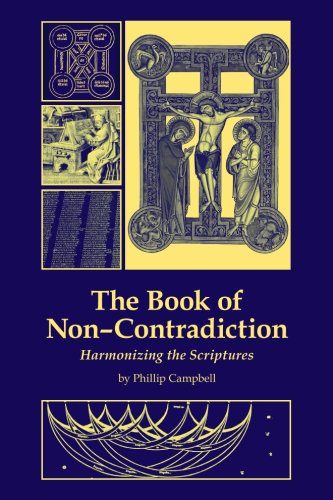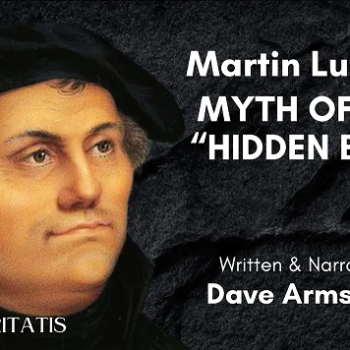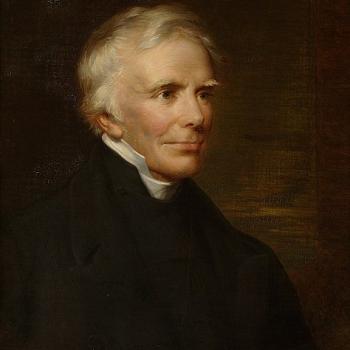
[Amazon image]
***
The full title of this book is, The Book of Non-Contradiction: Harmonizing the Scriptures (Grass Lake, Michigan: Cruachan Hill Press, 2017).
*****
Phillip Campbell has provided a very valuable service for Christians, in this defense of the inspiration of Scripture, in terms of showing how alleged biblical contradictions really aren’t contradictions at all. Having done a great deal of work in this area, myself, as a professional Catholic apologist, I know how prevalent such criticisms are: especially, these days, proceeding rather relentlessly (with seeming growing confidence) from our atheist friends. I like to describe the mentality of atheists in approaching the Bible as “the butcher and the hog.”
Mr. Campbell alludes to this widespread mistaken outlook in his Introduction, noting how the idea that the Bible is “full of contradictions” is:
. . . casually repeated in online forums, radio programs, and television interviews with the confidence of one saying the sky is blue or snow is cold. The critic assumes it, states it, and moves on, the argument left unproven because, in his mind, it is self-evident.
It was my own personal encounter with these sorts of assertions that inspired me to compile this book. (p. 6)
The Introduction is a brilliant summary exposition of a fool’s catalogue of accusations of contradictions, which are in reality, obvious (at least on close inspection) exercises in faulty logic. I have observed the same sorts of basic logical errors for many years, in my own encounters with “atheist exegesis” and with misinformed Christians who hold a “low” view of Holy Scripture (and, I submit, of reason and logic as well). It was a pleasure to see such goofball analyses decisively disposed of, one-by-one. Campbell describes and refutes typical instances:
Examples of these apparent contradictions are situations where one Gospel says Jesus was with Peter, James and John and the other Gospel says Peter, Andrew and John. There is no contradiction unless the latter Gospel specifically says, “James was not there.” . . . Many of the “contradictions” are of this sort. (p. 8)
[S]ome of the “contradictions” examined are just ignorant. For example, “Peter was chosen by the Sea of Galilee” and “Peter was chosen by the Lake of Gennesaret.” The Lake of Gennesaret and the Sea of Galilee are the same body of water. (p. 9)
The real problem is most of these skeptics who gloat in finding contradictions in the Bible have never bothered to really dig into the verses in question; many of the “contradictions” in this book evidence a glaring ignorance of not only the Bible itself, but even geography, conventional literary method, and basic linguistics. They do not care what the Bible really says; they care only about attacking Faith. (p. 11)
We will see a failure to recognize literary hyperbole and an insistence on taking every statement in the most absolute narrowest, most literal sense without any effort to determine the nuance involved in real human speech — in short, a failure to treat the Scriptures the way we approach any other writing. (p. 12)
Campbell provides another related general “principle” in chapter 15:
[W]e need to understand a certain Scriptural principle that we may call the Principle of Non-Exclusion. This means that when the Scriptures mention a certain event as occurring, other possible events not mentioned in the text are not thereby excluded, unless they directly contradict what is written. (p. 118)
He then applies the principle by examining the issue of how many angels were present in the first accounts of Jesus’ empty tomb on the first Easter Sunday:
Matthew has one, Mark one, Luke two, and John none. . . . if Luke mentions two, then there must have been two. The fact that Matthew and Mark mention one angel does not exclude the possibility of a second one not mentioned by them, as John’s exclusion of any angels does not mean they were not there, only that he chose not to mention them. (pp. 120-121)
Having laid this important presuppositional groundwork, Mr. Campbell then moves on to examine particular examples of misguided biblical criticism, in fifteen chapters devoted to major issues of alleged contradiction, and a final 70-page chapter briefly chronicling 191 further “difficulties.” I’d like to highlight what I thought were some of the best refutations in the book. Regarding the two accounts of creation in Genesis 1 and 2 (a favorite of Bible critics since time immemorial), he writes:
[T]he events in chapter 2 are not meant to happen after the events in chapter 1. Rather, chapter 1 presents a broad picture, followed by a kind of “zoomed in” perspective in chapter 2, which re-presents certain events from chapter 1 but in greater detail. This method is common throughout Genesis; for example, Genesis 11 tells of the various families descended from Shem and then Genesis 12 goes on to “zoom in” on a specific family – that of Abram. (p. 17)
My favorite chapter was the last one, with 191 debunked alleged contradictions. For the purpose of this review, and the limited space I have, many of these are well-suited for representative citation. #7 dealt with Jesus being called both Emmanuel and Jesus. Oddly enough, this is thought to be a biblical contradiction. Campbell retorts:
Emmanuel was never understood to be a proper name. It is a prophetic title originating with the prophet Isaiah (Is. 7:14) and denotes the Messiah as a manifestation of God’s presence among His people. (p. 127)
#14 is a claim that the Bible asserts that Jesus began His ministry before John the Baptist’s arrest (Jn 3:22-24) and also (in alleged contradiction) that He began it after his arrest (Mk 1:13-14). The reply is a simple one:
Jesus began His ministry in Judea prior to John’s arrest . . . but did not begin in Galilee until after . . . Remember, Judea and Galilee are two different territories. (p. 129)
#38 has to do with whether a Christian ought to judge (1 Jn 4:1-3) or not judge (Mt 7:1-2 ). Campbell explains:
These verses are two totally different contexts. Matthew refers to the faithful not being judgmental and condemnatory towards other people, 1 John refers to the necessity of Christians understanding the difference between good and evil spirits, or what has been called “discernment of spirits.” (p. 138)
#51 deals with a dispute that has been front and center with our separated Protestant brethren for 500 years now:
51. Salvation comes by faith and not works (Eph. 2:8, 9; Rom. 11:6; Gal. 2:16; Rom. 3:28).
Salvation comes by faith and works (Jas. 2:14, 17, 20).The “works” referred to in St. Paul are the ceremonial “works of the law”, rituals of the Old Covenant no longer binding on Christians. The “works” referred to in St. James are good works, works done in charity, which are obligatory for Christians. These are two different types of works. (pp. 141-142)
Certain Protestant scholars of the “new perspective on Paul” outlook, such as Bishop N. T. Wright, are now agreeing with the above analysis, instead of casually assuming that every time “works” are mentioned, that they must be of the same type. In this way, Protestants historically, have fallen into the same sort of “one size fits all” mentality that characterizes atheist (and also, I might add, wooden literalist fundamentalist) “exegesis.” We must all be aware of different senses of words in Scripture, according to context, and of literary genre as well.
#77 tackles a classic objection: the cock described as crowing once (Mt 26:74) and twice (Mk 14:72), in a very effective, illuminating way:
This is stupid. Matthew does not say how many times the cock crowed, only that it crowed. If you were to say, “The dog barked,” would the only possible interpretation be that it barked once and only once? Does not the phrase “the dog barked” have a more general meaning that could refer to a single bark, two barks, or five minutes of incessant barking? This is another example of how these people are unwilling to extend the same common usages to words and phrases of the Bible that they utilize in their everyday use of speech. (p. 151)
#153 has to do with a seeming contradiction that has to do with what I would call the “proverbial” use of language in the first epistle of John. 1 John 1:7-8 states that Christians can and do sin (RSV: “If we say we have no sin, we deceive ourselves”), but 1 John 3:9 asserts they will not or cannot sin (“No one born of God commits sin; for God’s nature abides in him, and he cannot sin because he is born of God”). Campbell explains:
1 John 3 refers to abiding in a state of mortal sin. 1 John 1:7-9 refers to the fact that even among Christians nobody is absolutely sinless. The message is that while even Christians will fall into sin from time to time, one cannot claim to be a follower of God while habitually living in unrepentant mortal sin. (p. 182)
I would add that 1 John 5:16-17 refers to sins that are “mortal” five times; thus, this explanation has the support of context.
These examples provide a flavor of the entire book. I think it is an indispensable apologetics tool for anyone who deals with biblical skeptics: be they more liberal and “dissident” Catholics or other Christians, or atheists who savor every opportunity to mock Christians and their “primitive” and allegedly “full of holes” Bible.
Moreover, it will greatly help persons who seek (with an open mind) to learn more about the Bible, and why Christians believe it is infallible and inspired, to see many reasons for why we believe in its inspiration. This book will help build faith and confidence in Christians, while it refutes the false claims of the avowed enemies (or severe critics) of Christianity and the Bible.
I give it my very highest (and enthusiastic) recommendation.
See also the Amazon book page.













